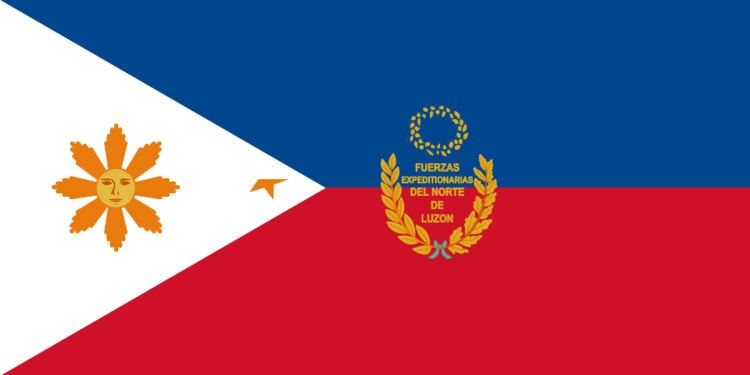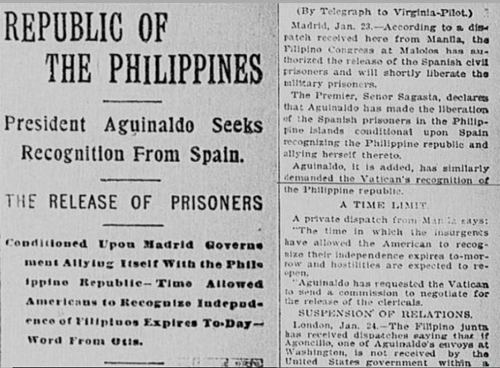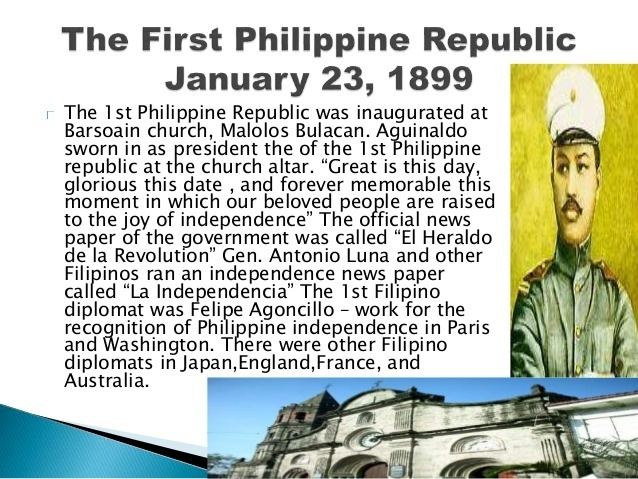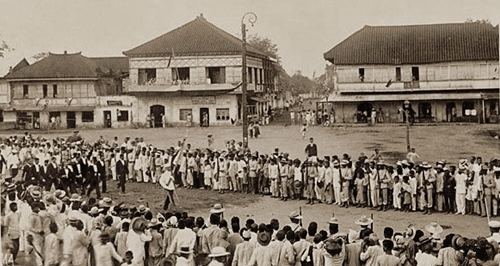Area 300,000 km² Date dissolved 1901 | Founded 1899 | |
 | ||
Religion Roman CatholicismPhilippine Independent Church 1901–1902 Miguel Malvar (unofficial) | ||
The Philippine Republic (Spanish: República Filipina, Filipino: Republikang Pilipino), more commonly known as the First Philippine Republic or the Malolos Republic, was a nascent revolutionary government in the Philippines. It was formally established with the proclamation of the Malolos Constitution on January 23, 1899, in Malolos, Bulacan, and endured until the capture of President Emilio Aguinaldo by the American forces on March 23, 1901, in Palanan, Isabela, which effectively dissolved the First Republic.
Contents
- First philippine republic
- History
- PhilippineAmerican War
- National cabinet
- Provincial and local government
- Finances
- Military
- Malolos the Official Capital of the First Philippine Republic
- Sideco house Emilio Aguinaldos Office at Nueva Ecija
- References

The First Philippine Republic was established after the Philippine Revolution against Spanish Empire (1896-1897) and the Spanish–American War between Spain and the United States (1898). Following the American victory at the Battle of Manila Bay, Aguinaldo returned to the Philippines, issued the Philippine Declaration of Independence on June 12, 1898, and established a revolutionary Philippine government. In December 1898, Spain sold the Philippines to the United States in the 1898 Treaty of Paris, making the United States formally the Philippines colonial power. The Malolos Constitution establishing the First Philippine Republic was proclaimed the following month. The Philippine–American War began in February 1898, which the Philippine Republic lost.

The Philippine Republic was the first constitutional republic in Asia. Although there were several Asian republics predating the First Philippine Republic for example, the Republic of Formosa or the Republic of Ezo, the Republic at Malolos was the first to frame a comprehensive constitution duly approved by an partially elected congress.

First philippine republic
History

In 1896, the Philippine Revolution began against Spanish colonial rule. In 1897, Philippine forces led by Aguinaldo signed a ceasefire with the Spanish authorities and Aguinaldo and other leaders went into exile in Hong Kong. In April 1898, the Spanish–American War broke out. The U.S. Navy's Asiatic Squadron, then in Hong Kong, sailed to the Philippines to engage the Spanish naval forces. On May 1, 1898, the U.S. Navy decisively defeated the Spanish Navy in the Battle of Manila Bay. Later in May, Aguinaldo returned to the Philippines, established a dictatorial government on May 24, 1898 (formally established by decree on June 18), and on June 12, 1898, at Aguinaldo's ancestral home in Cavite, issued the Philippine Declaration of Independence from Spain. Following the proclamation of independence Aquinaldo established a revolutionary government on June 23, 1898, under which the partly elected and partly appointed Malolos Congress convened on 15 September to write a constitution.
On December 10, 1898, the 1898 Treaty of Paris was signed, ending the Spanish–American War and transferring the Philippines from Spain to the United States.
The Malolos Constitution written by the congress was proclaimed on 22 January 1899, creating what is known today as the First Philippine Republic, with Aguinaldo as its president. The constitution was approved by delegates to the Malolos Congress on January 20, 1899, and sanctioned by Aguinaldo the next day. The convention had earlier elected Aguinaldo president on January 1, 1899, leading to his inauguration on January 23. Parts of the constitution giving Aguinaldo the power to rule by decree are of particular interest. The constitution was titled "Constitución política", and was written in Spanish
Philippine–American War
When it was constituted on January 22, 1899, in Malolos, that municipality became the seat of government of the Philippine Republic, and was serving as such when hostilities erupted between U.S. and Filipino forces in the Second Battle of Manila on February 4. American forces pushing north from Manila after the outbreak of fighting captured Caloocan on February 10. On March 29, as American forces threatened Malolos, the seat of government moved to San Isidro, Nueva Ecija.
On February 4, 1899, armed conflict erupted in Manila between Philippine Republic forces and American forces occupying the city subsequent to the conclusion of the Spanish–American War. That day President Aguinaldo issued a proclamation ordering and commanding that "peace and friendly relations with the Americans be broken and that the latter be treated as enemies, within the limits prescribed by the laws of war." The fighting quickly escalated into the Second Battle of Manila, with Philippine Republic forces being driven out of the city. On March 31, American forces captured Malolos, the initial seat of the Philippine Republic government, which had been gutted by fires set by withdrawing Philippine Republic forces. Emilio Aguinaldo and the core of the revolutionary government had by then moved to San Isidro, Nueva Ecija. Peace negotiations with the American Schurman Commission during a brief ceasefire in April–May 1899 failed, and San Isidro fell to American forces on May 16. The Philippine Republic core government had moved by then to Bamban, Tarlac, and subsequently moved to Tarlac town. Aguinaldo's party had already left Tarlac, the last capital of the Philippine Republic, by the time American troops occupied it on November 13.
American forces captured Calumpit, Bulacan on April 27 and, moving north, captured Apalit, Pampanga with little opposition on May 4 and San Fernando, Pampanga on May 5. This forced the seat of government to be shifted according to the demands of the military situation.
In October 1899 American forces were in San Fernando, Pampanga and the Philippine Republic was headquartered not far north of there, in Angeles. On October 12, an American offensive to the north forced the Philippine Republic to relocate its headquarters in November to Tarlac, and then to Bayombong, Nueva Vizcaya. On November 13, under pressure by American forces, Aguinaldo and a party departed Bayombong by rail for Calasiao, Pangasinan, from where they immediately proceeded eastwards to Sta. Barbara in order to evade pursuing American forces. In Sta. Barbara, they joined a force of some 1200 armed men led by General Gregorio del Pilar.
On November 13, in a conference in Bayambang, Pangasinan, Aguinaldo decided to disperse his army and begin guerrilla war. From that point on, distance and the localistic nature of the fighting prevented him from exercising a strong influence on revolutionary or military operations. Recognizing that American troops blocked his escape east, he turned north and west on 15 November, crossing the mountains into La Union province. Aguinaldo's party eluded pursuing American forces, passing through Tirad Pass near Sagada, Mountain Province where the Battle of Tirad Pass was fought on December 2 as a rear guard action to delay the American advance and ensure his escape. At the time of the battle, Aguinaldo and his party were encamped in Cervantes, about 10 km south of the pass. After being notified by a rider of the outcome of the battle and the death of del Pilar, Aguinaldo ordered that camp be broken, and departed with his party for Cayan settlement. Aguinaldo was captured by American forces on March 23, 1901 in Palanan, Isabela. Following his capture, Aguinaldo announced allegiance to the United States on April 1, 1901, formally ending the First Republic and recognizing the sovereignty of the United States over the Philippines.
Aguinaldo's party, traveling with del Pilar's force, reached Manaoag, Pangasinan on November 15. There, the force was split into vanguard and rear guard elements, with Aguinaldo and del Pilar in the vanguard. The vanguard force overnighted in Tubao, La Union, departed there on November 16, and was in Naguilian, La Union by November 19, where word was received that American forces had taken Santo Tomas and had proceeded to Aringay. Aguinaldo's force arrived in Balaoan, La Union on November 19, pushed on the next day, and arrived at the Tirad Pass, a natural choke point, on November 23. General del Pilar decided to place a blocking force in Tirad Pass to delay pursuing American forces while Aguinaldo's party moved on.
The Battle of Tirad Pass took place on December 2, 1899. 52 men of del Pilar's 60 man force were killed, including del Pilar himself. However, the Filipinos under del Pilar held off the Americans long enough for Aguinaldo's party to escape. Aguinaldo, encamped with his party about 10 km south of the pass in Cervantes, Ilocos Sur, was apprised of the result of the battle by a rider, and moved on. The party reached Banane settlement on December 7, where Aguinaldo paused to consider plans for the future. On December 16, the party departed for Abra to join forces with General Manuel Tinio. The party traveled on foot through a pass at the summit of Mount Polis, and arrived at Ambayuan the next morning. The party pushed on to Banane, pursued closely by American forces. At this point, Aguinaldo's party consisted of one field officer, 11 line officers, and 107 men. The remainder of December 1899 was spent in continuous trek.
The party was at the border of Abra and Cagayan provinces on Aguinaldo's 31st birthday on March 23, 1900. The trek from place to place continued until about May 22, 1900, when Aguinaldo established a new headquarters in Tierra Virgen. On August 27, 1900, after American forces landed at Aparri, Cagayan, Aguinaldo concluded that Tierra Virgan had become untenable as a headquarters and decided to march to Palanan, Isabela. On December 6, 1899, the party reached Dumasari, and arrived in Palanan the following morning. Aguinaldo remained in Palanan until his capture there by American forces with the aid of the native scouts on March 25, 1901.
National cabinet
Article 73 of the constitution established a Council of Government (Cabinet), composed of a President and seven Secretaries. The following individuals were appointed to Cabinet positions:
The cabinet only met in a few times in 1899.
Provincial and local government
Municipal and provincial governments under the Republic had quickly reorganized upon Aguinaldo's decrees of June 18 and 20, 1898. The Malolos Constitution had cited on Article 82 the organization of provincial and popular assemblies which had the power of taxation.
Finances
One of the important laws passed by the Malolos Congress was the law providing for a national loan to buoy the national budget in which the Republic was trying to balance. The loan, worth 20 million pesos, was to be paid in 40 years with an annual interest of six percent. The law was decreed by Aguinaldo on November 30, 1898.
Military
When Philippine independence was declared on June 12, 1898, the Philippine Revolutionary Army was renamed the Philippine Republican Army. Aguinaldo then appointed Antonio Luna as Director or Assistant Secretary of War by September 28, 1898, and the Philippines first military school, the Academia Militar was established in Malolos.
When the Republic was inaugurated on January 23, Luna had succeeded Artemio Ricarte as the Commanding General of the Republican Army. With such powers at hand, Luna attempted to transform the weak, undisciplined revolutionary army into a disciplined regular army for the service of the Republic.
Malolos, the Official Capital of the First Philippine Republic
In September 1898 General Emilio Aguinaldo made the Paroquia dela Inmaculada Concepcion an Augustinian erect town church of Malolos (now Cathedral Basilica) as the executive palace while the nearby Barasoain Church served as the legislative house where the Malolos Constitution was made. When the Americans captured Malolos Aguinaldo ordered General Antonio Luna to burn the Malolos Church including its huge silver altar.
Sideco house (Emilio Aguinaldo's Office at Nueva Ecija)
The house had been the seat of General Emilio Aguinaldo's First Philippine Republic when he established it as his headquarters in San Isidro during the last part of his odyssey from the American forces.
On the 29th of March 1899, Gen. Emilio Aguinaldo arrived in San Isidro, Nueva Ecija and the town made as temporary capital of the First Philippine Republic. He stayed in this house which served as his executive office. When the Americans occupied San Isidro, the Sideco house served as the headquarters of Col. Frederick Funston who would later capture General Aguinaldo in Palanan, Isabela. General Aguinaldo's capture is said to have been planned in this house. It is now occupied by a Christian organization.
